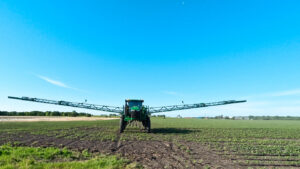Editor’s Note: Tom Blair is senior vice president of the performance analytics division at Iteris, the applied informatics and big data company. He leads a team of 100 data, computer, and agronomic scientists. Iteris focuses on the agriculture and transportation sector and is the founder of ClearAg, a weather-focused precision ag platform. ClearAg has recently launched a new modeling-as-a-service platform, and here Blair describes what agricultural modeling is and how it could help farmers and agribusinesses make better decisions.
Agricultural modeling is an underserved market. Billions of dollars have been spent on field tests, genetic development, weather and soil sensors, and research associated with the performance of crops, and their nutrition and protection. But relatively little has been spent on the analysis and forecasting of the complex interaction of the weather, with soil and water’s influence on crop growth, health and performance in the field.
Modern agriculture is a modified natural ecosystem, a networked web of chemical, biological, mechanical and technological environments. These systems are interdependent; a change in one can produce changes in the other systems. For instance, if the weather becomes warmer and more humid, this may lead to the quick development of a plant disease, or a need to irrigate at different times. All of these systems impact agribusiness in the most important dimension: yields and the overall profit or loss of the operation.
Agricultural modeling can be useful for harnessing this complexity and to solve the practical problems present in agriculture today.
Ag models ingest massive amounts of data and use powerful software analytics to help predict what will happen into the future and so can help reduce the inherent risk in agriculture from an evolving climate and its impact on food security, commodity markets and input costs. But what are these magic models? How do they stack up to physical IoT sensor networks?
Agriculture models are algorithms that attempt to emulate a complex biological environment. There are many classes of models in today’s scientific arsenal; models such as statistical, mechanistic, deterministic, stochastic, dynamic, and simulations that can be used to explain, understand and improve the overall performance of the biological system.
Regardless of the type of modeling employed, or the application for which it is being used, weather and soil conditions are the most important variables for both tactical and strategic decision making. To accurately model the risk associated with weather, simulations are often conducted in context to long, historical periods, often taking into account 30 years of historical information to account for the various management scenarios such as long-term crop rotation and crop sequencing models.
The world of agricultural modeling provides benefit throughout the entire cropping season and runs the gamut of science discipline, including ensemble weather forecasting and agronomic land surface modeling — that accurately predicts soil temperature and moisture — and algorithms and systems, which model nitrogen loss, predict plant wilting points and the potential for the emergence of pests or diseases. Models have been proven to be very cost-effective tools for predicting the possible impact of climatic and technological change on crop growth and yield.
How can growers and agribusinesses alike benefit from agricultural modeling?
Crop modeling applications can be used in strategic decision-making such as helping to determine which cultivar to plant. They can also be used for practical applications that help to determine when to harvest based on weather conditions and fuel, and they can forecast applications that prescribe treatment recommendations based upon the predicted future condition of the crop and the predicted weather risk assessment.
Models also complement, and in certain applications, replace the need to employ physical sensors. Although agricultural modeling can be expensive and complex, it solves many of the major problems associated with agricultural sensing: how to overcome the inherent limitations of sensors. They are generally sparse, faulty and expensive to repair, calibrate and to replace.
To help minimize cost and complexity, and to minimize the impact of business-plan-wrecking service costs associated with sensor networks, we have developed a new agricultural modeling service that we think “fills in the gaps” of sparse networks and provides the wall-to-wall environmental sensing coverage global agribusinesses need.
ClearAg Modeling-as-a-Service (MaaS), is an add-on service for our ClearAg platform subscribers, who receive historical, real-time, and forecast weather, water, soil, crop growth and crop health content derived from land surface modeling, crop modeling, and software analytics.
By employing ag models in conjunction with relevant weather and soil data, growers and agribusinesses can reduce risk and increase crop yields by providing environmental information relevant to each specific field, cultivar and crop protection application.
One existing client—the Minnesota Wheat Research and Promotion Council—utilizes ClearAg MaaS to help Minnesota farms with decision support in fungicide applications. Through our mobile platform, Minnesota farmers can access high-resolution weather, water, soil, pest, and disease information in real-time, so they can simulate the potential for crop disease and consequently make data-driven and science-backed decisions regarding fungicide applications.
In a changing climate, the ability to accurately predict when to plant, when to irrigate, when to apply nutrients, or when the potential for pest or disease infestation may occur, becomes essential to our ability to feed the world and to make a profit in doing so. Agricultural modeling can help reduce the use of inputs by reducing loss resulting from environmental conditions; it can automate compliance reporting, and it can simultaneously increase both crop yields and environmental sustainability through better science and real-time access to information.
In helping us reduce the inherent risk in agriculture, the use of ag models can help to protect us all from a changing climate and the impact it has on food security, our financial markets, and our global prosperity.
What do you think? Is agricultural modeling the future? Get in touch [email protected].




